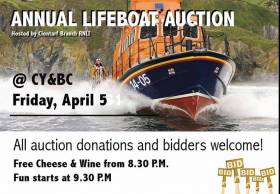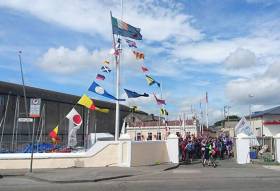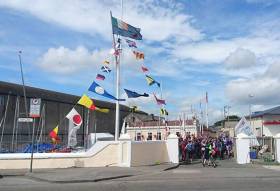Displaying items by tag: CY&BC
Clontarf Baths Left ‘Destroyed’ by Storm Betty
The Clontarf Baths have been left “destroyed” by the impact of Storm Betty as it passed over Ireland late on Friday and early Saturday (18-19 August), as RTÉ News reports.
A lifeguard at the baths who joined the clean-up operation on Saturday morning said damage caused is “very upsetting” and it could be up to a fortnight before the baths are returned to normal.
“It’s paradise working here, and to see it like this after the work we’ve put in to keep it clean and safe, and it’s just destroyed,” Anne Miller said.
Boats from nearby Clontarf Yacht & Boat Club were also damaged by the storm, with a wooden Kestrel that’s been in the club for nearly 50 years among three vessels affected.
Across Dublin Bay in Dun Laoghaire, a Cape 31 was blown off its hard-standing cradle and into the water, where it was later retrieved by crane.
RTÉ News has more on the story HERE.
Clontarf to Host Delayed 75th Jubilee Celebration for IDRA 14 Class
The IDRA 14 Class Association invites all former owners and crews to join in the celebrations to mark its postponed 75th jubilee at Clontarf Yacht & Boat Club on the weekend of Saturday 3 and Sunday 4 September.
All are welcome to come along, meet old friends and participate in — or just watch and enjoy — the events on the weekend.
Current boatowners are especially urged to bring their boats along if possible to join in the festivities on the water. The entry fee is just €20 per boat, and every boat will receive a class memento.
The celebrations actually get under way on Friday 2 September with welcome drinks at the clubhouse for UK visitors from the IDRA 14’s sister class the Waldringfield Dragonflies.
Saturday’s racing from 2.30pm will be followed at 6.30pm by a ‘pig on the spit’ barbecue which is unfortunately already fully booked. However, burgers will be available on the evening, and there will be music in the club from 8pm.
Sunday stars with a rally of all boats in the club grounds at 2pm, with racing for former sailors (no entry fee required). There will also be an allocation of boats to former owners and crews (3pm) for a sail-past (3.40pm) and racing (4pm), followed at 6pm by the weekend’s prize-giving ceremony with refreshments and the cutting of the jubilee cake at the clubhouse.
Throughout the weekend archive film and photos of the 14s and CY&BC as well as class memorabilia will be shown in the clubhouse.
For further information contact your local class captain or IDRA 14 Commodore Ian Sargent at 087 679 1069 or [email protected].
The class will also host a jubilee dinner at the Royal St George in Dun Laoghaire from 7.30pm on Saturday 8 October. Dress code is jacket and tie. For bookings and more details contact Suzanne McGarry 087 242 5331 or Therese Clarke 086 150 3013.
Triumph For Skerries At 2019 E-Boat Nationals In Clontarf
With the passing of the Summer Solstice, it was time again to focus one’s gaze from celestial to nautical observations, in particular the E-Boat National Championships of 2019 hosted over the weekend of 6-7 July by Clontarf Yacht & Boat Club, writes Findlay MacDonald.
Ian Sargent was this year’s Principal Race Officer. He made use of the very light conditions, wisely choosing to set two days of sailing within the confines of Dublin Port. Setting courses on the open sea and strong tide would have hampered and delayed racing and would not have allowed a full six races to be run.
Nevertheless, in near perfect ‘lake conditions’, excellent courses were set each day providing lively competition for all — testing both tactics and boat-handling of all competitors.
This year’s Nationals saw a good turnout of six local boats and three very warmly welcomed boats from the Skerries Sailing Club fleet, which sailed down to Howth the evening before and headed straight to the start line on Saturday morning (Eaglet, due to engine trouble, unfortunately missed the first race).
Last year’s champion Pat O’Neil and OctopussE were not present, with him being heavily engaged in campaigning his J80 and preparing for their World Championships in Spain (though missed, we wish him well in his endeavours and await his return to the fleet). With several boats in ascendancy in both fleets, odds were even across four to five boats on who might lift this year’s crown.
Steady light airs (5-7 knots) were generally from the East for the weekend, meaning ‘clean air’ was the most important criteria. Skerries’ Easy Go in Race 1 and 2 (windward returns) sped off the start line in good air avoiding congestion at the committee boat. Enchantress, and Eagle Eye (CY&BC) who showed good form in club racing this season, followed but failed to catch Easy Go who claimed the first 2 races.
The battle for second and third was very open
Race 3 saw a change in course layout from an Offset to an Olympic. Wylie Coyote finished with a commanding lead in a hotly contested race where positions from first to fourth fluctuated on each leg. Eaglet finished second, and Easy Go scored third to finish the day with a clear points lead. The battle for second and third was very open.
On Day 2, the race officer took full advantage of the space within the entire harbour, setting excellent Olympic courses. The second leg, a run down close to Bull Island promenade, made a perfect grandstand for onshore spectators and Sunday strollers.
Again, conditions were light but constant, requiring only slight course alterations between races which were run efficiently and promptly, and started with little bias in the start line.
Race 4 saw Enchantress executing a perfect race, leading with pace from the line to the finish, tactically controlling the race from the front. In Race 5, Enchantress, on port, found themselves rolled at the top mark as they were closed out of the lay-line as the fleet came around closely packed together. Good boat handling saw Enchantress come back to third. The race went to Easy Go who now had a commanding lead in the series. Skerries’ Eaglet again showed strong form and saw off competition to finish second in the race.
For the last race of the day, winds were waning but still a fiercely contested race was had. Local boats Euro and Wylie contested valiantly but were no match for Easy Go and Eaglet. Easy Go looked good for a fourth bullet at the last mark rounding, but Eaglet had the speed on the sprint to the line and claimed a deserved first. Euro, having been in the running for the race, just didn't quite have enough juice in the engine and finished the day only yards behind second.
Wylie Coyote and Eagle Eye in the last 100 yards looked good for claiming fourth but were beaten by the beautiful E-Type who came up the last beat at speed on a fresh breeze after rounding the last mark in seventh.
With many boats sporting fresh crew, it was good to see a mix of results and closeness in the racing
In 15 years of competing in the E Boat Nationals, this year’s deserved National Champion was Paul Hick and his seasoned team on Easy Go. A strong performance and result that was a long time coming, it was great to see them succeed having missed out previously by only a few points. Enchantress (skipper Findlay MacDonald) and Eaglet (skipper Bernie Grogan) were this year’s runners-up.
With many boats sporting fresh crew, it was good to see a mix of results across the championship and closeness in the racing. There is great potential in the fleet and next year’s championship will again be hotly contested as crews refine and boats improve. Thanks goes to the hosts at CY&BC, and all crews for enthusiasm and camaraderie for making e-boats a fun and lively class.
The E-Boat Class comprises classic IOR Mini-Tonner light displacement racing yachts, designed by Julian Everett — designer of many an elegant yacht. They are a competitive one-design, rate well in IRC and have won the ICRA National Championships. Fleets in Skerries and Clontarf remain active and engaged and are always welcoming of new boats and skippers.
Friday night is sure to be a winner on Dublin Bay as Clontarf Yacht & Boat Club hosts its annual auction night in aid of the Howth RNLI lifeboat tonight, Friday 5 April.
Gary Sargent and Elaine Ball will host the auction from 9.30pm with many items up for bidding, including vouchers for Irish Ferries and Stena Line.
The CY&BC also invites attendees to bring along their own items for auction to raise finds for the lifesaving charity.
Complimentary wine and cheese will be served for those who come early from 8.30pm.
Clontarf Yacht and Boat Club will host its fourth annual Sail Against Suicide event on Saturday 25 August from 10am to 4pm.
Sail Against Suicide event is an initiative from Jessica Clohisey, one of the junior members of the club on Dublin’s Northside, who wanted to share her love of sailing while raising awareness about suicide.
“Clontarf Yacht & Boat Club is a community based, volunteer run club and we are keen to provide constructive support to the wider community,” said Commodore Andrew Semple.
“Mental health and the challenges around the issue are very really important and this event does a lot to provide information and raise awareness.”
Semple emphasised that Sail Against Suicide “is not a fundraising event – its purpose is simply to raise awareness of mental health issues that affect every community in Ireland and bring the topic into focus.”
This year’s day is also a Try Sailing event, part of the programme launched by Irish Sailing to encourage more people to take up sailing and other watersports.
“Participants can just turn up and we will get them out sailing all for free,” Semple said. “Clontarf Yacht & Boat Club have combined Try Sailing with Sail Against Suicide as the mental health benefits of sailing are well documented and we want to encourage as many people as possible to the club to raise awareness and have some fun.
“This is a free fun event. We aim to get 150 people on the water and will welcome more watching from the promenade. There will be music, food, entertainment, information and, above all, awareness.”
The Try Sailing Event is open to all. For more information or to register to go out sailing, contact [email protected].
Clontarf Yacht & Boat Club Benefits From 2017 Sports Capital Grants
#SailingGrants - Among the 30 Irish sailing clubs to benefit in the latest round of Sports Capital Grants is Clontarf Yacht & Boat Club, which was awarded €136,000 to increase equality of access with a new wet room and a much-needed extension of the women’s changing area.
“The allocation of this grant is great news for CY&BC,” said Commodore Andrew Semple. “We are a small volunteer based club who have worked over recent years to make sailing and water sports more accessible to all of the community.
“For the past several years we have run very successful ‘Gone Fishing’ days for our friends in the Central Remedial Clinic and St Michael’s House and we also host an annual Try Sailing event with the support of Irish Sailing to encourage more people to get on the water.”
“In the last few years we have also seen an additional number of women joining our club and participating in sailing and other events and our facilities have not matched the increased demand.”
“This vital funding will allow us to increase our equality of access with a new accessible wet room and a much needed expansion and refurbishment of the women’s changing rooms.”
Semple added: “As we are a small, volunteer-run club, this kind of financial support will have an incredible impact and help us invest in our future. We are grateful to Minister Richard Bruton TD, Minister of State Finian McGrath TD, and Seán Haughey TD for their support.”
CY&BC’s volunteers will be fundraising for the RNLI at the annual Christmas Day Swim later this month, as reported yesterday on Afloat.ie.
Lough Ree’s Graf & Smith Win 2017 Mirror Easterns
#Mirror - Ben Graf and Hannah Smith of Lough Ree Yacht Club topped the table at the 2017 Mirror Eastern Championships in Clontarf last weekend.
The duo pipped their club-mates Caolan Croasdell and Alexander Farrell in a reversal of their fortunes at the Mirror Worlds a month ago, where they placed 15th and 13th respectively as the best of the Irish in Falmouth.
Oscar Langan and Lughaidh Croasdell (CY&BC/Lough Ree YC) made it a top-three shutout for the Shannon sailing club. Full results can be found on the Mirror Sailing Ireland Facebook page.
Clontarf Yacht & Boat Club hosted the six races over the weekend of Saturday 26 and Sunday 27 August, as previously reported on Afloat.ie.
Clontarf Hosts Mirror Easterns Next Weekend
#Mirror - The Clontarf Yacht & Boat Club is hosting the International Mirror Class Association of Ireland’s Mirror Eastern Championships for 2017 later this month.
Six races are scheduled over the weekend of Saturday 26 and Sunday 27 August, with prize-giving to take place in the clubhouse on the Sunday evening.
A barbecue will also be held for competitors and their families on the Saturday at 6.30pm priced at €15 a head for beef or salmon with salad dessert and €10 for children.
The Notice of Race, sailing instructions and entry form are available from the CY&BC website.
Clontarf Prepares To Sail Against Suicide
#CB&YC - Sail Against Suicide will take place for the second year running on Saturday 9 September hosted by the Clontarf Yacht & Boat Club.
The event was started last year by local youth sailor Jessica Clohisey, inspired by her role as a student leader ambassador for Cycle Against Suicide — an annual initiative to combat the negative stigma surrounding mental health.
Clohisey’s efforts were met with overwhelming support from the community, who kindly donated over €1,000 that was split between Cycle Against Suicide and mental health charity Aware, as Clontarf.ie reports.
Sail Against Suicide is not a fundraising event — its purpose is simply to raise awareness of mental health issues that affect every community in Ireland and bring the topic into focus.
TheJournal.ie recently spoke to Clohisey about her awareness-raising efforts.




































































